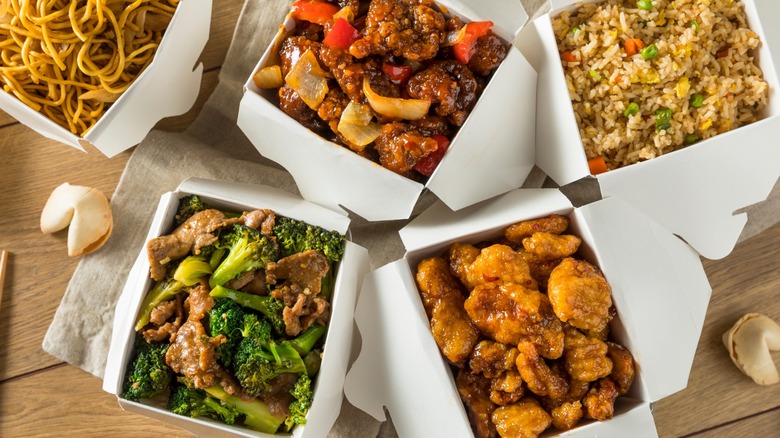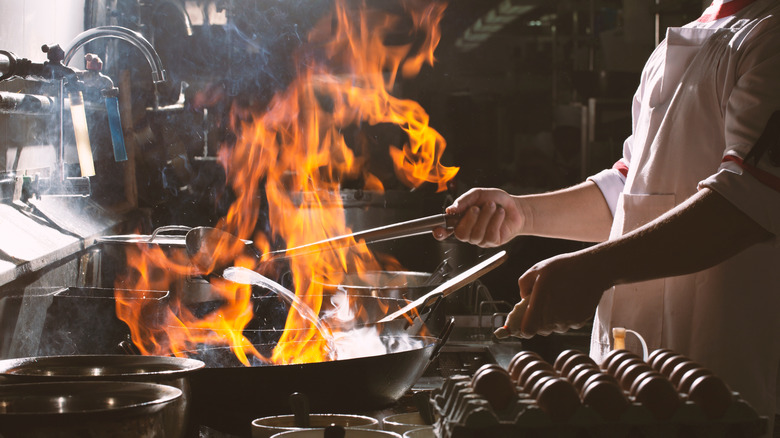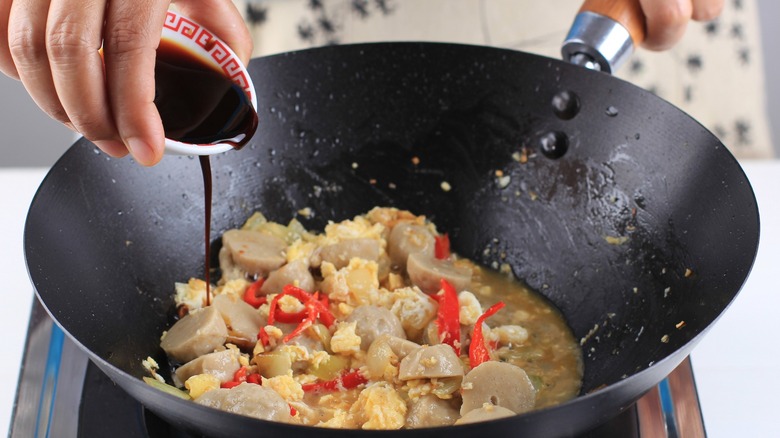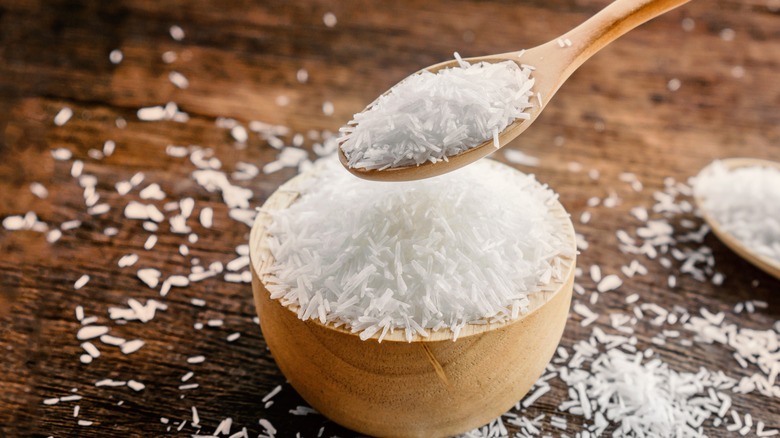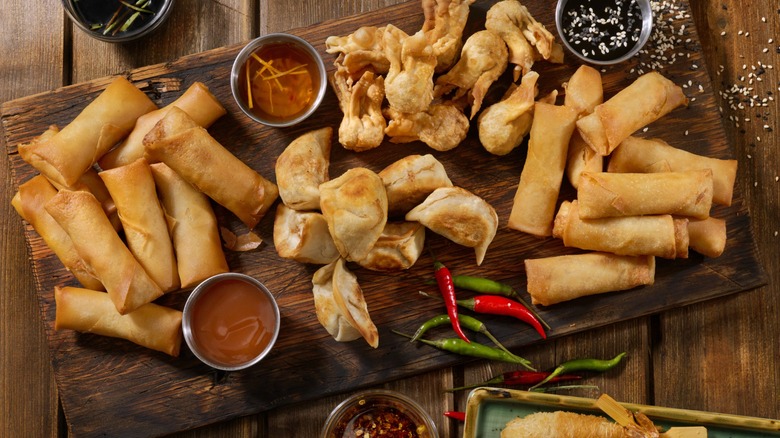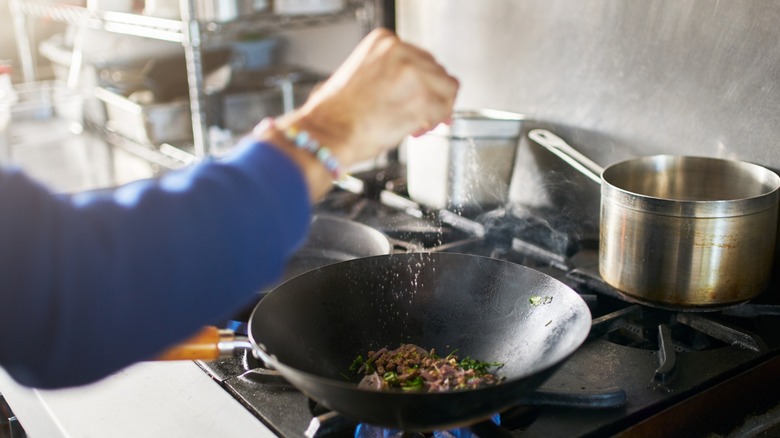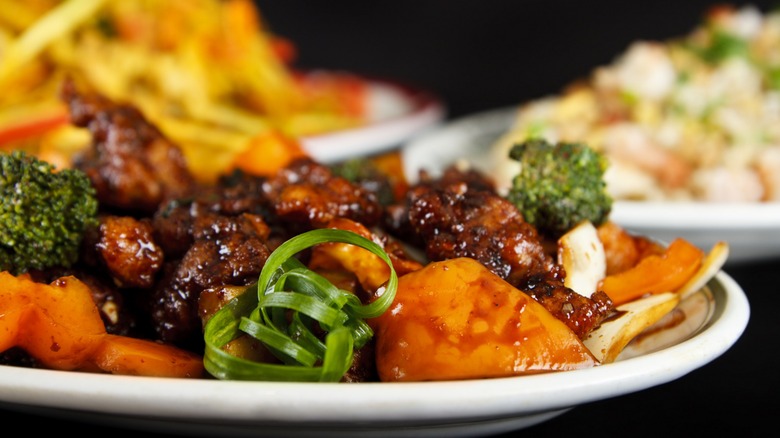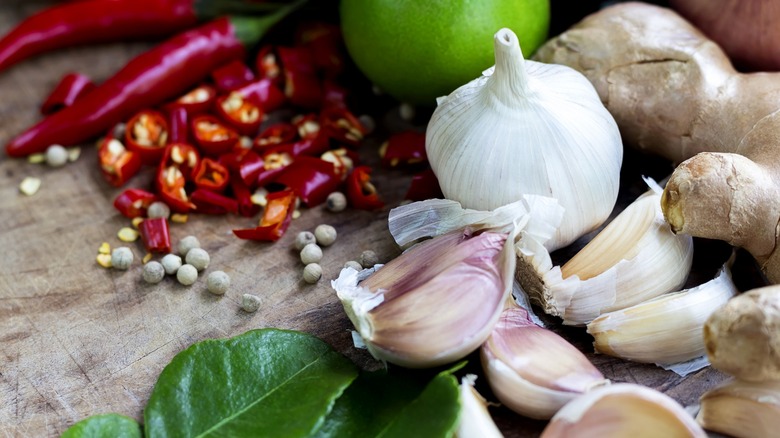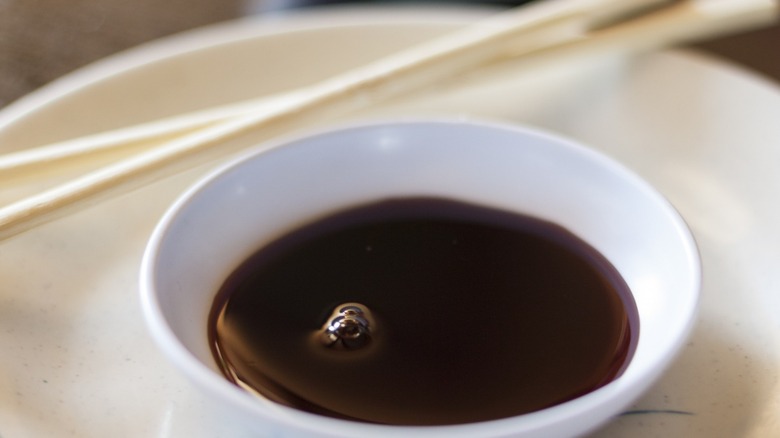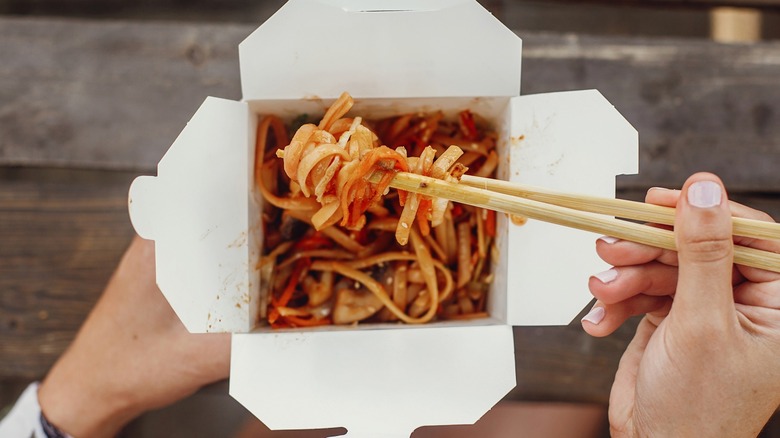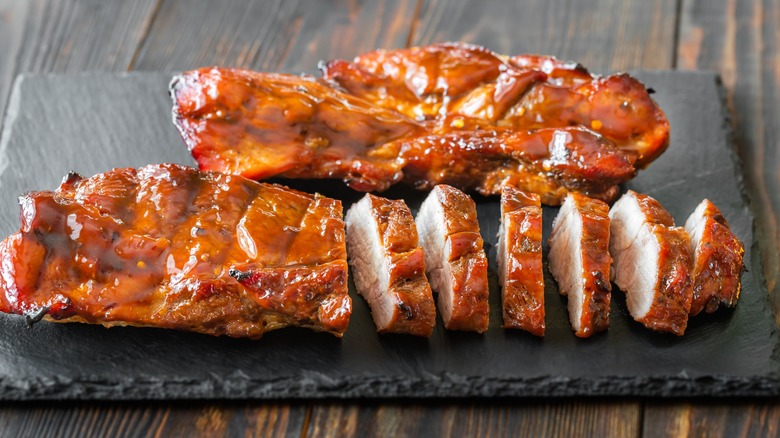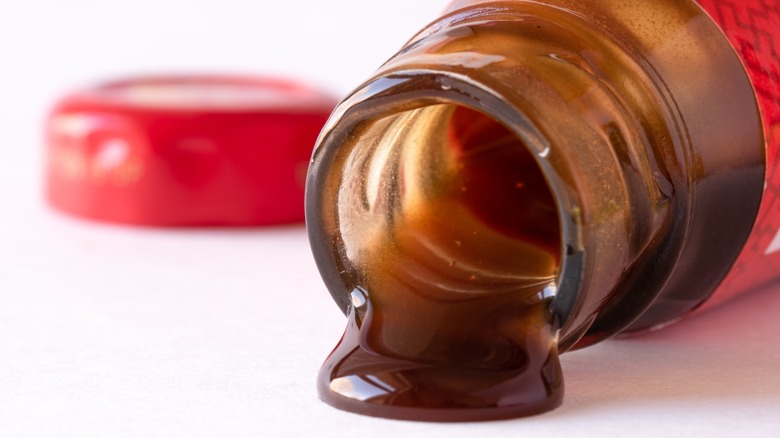This Is Why Homemade Chinese Food And Takeout Taste So Different
There's nothing quite like Chinese takeout. Sweet, salty, a bit greasy, often a bit spicy, and simply moreish. Indulging in a takeout after a hectic day at work or a busy week feels like a real treat, especially when you can't be bothered cooking.
Whether your favorite dish is beef with broccoli, General Tso's chicken, honey chili prawns, or fried rice with char siu pork, somehow, your local Chinese takeout makes everything taste so good. So why, when you try to recreate your favorite takeout dishes at home, are they just never quite as tasty?
It turns out there are a few reasons for this — and your local takeout probably has quite a few tricks up its sleeve. Let's look at why homemade Chinese food and takeout taste so different — and how you can make your home-cooked Chinese dishes taste more like takeout using information from American-Chinese food chefs and other professionals.
It's all about Wok Hei
Whether you're cooking on a gas burner or electric stove at home, you're never going to be able to achieve the high temperatures achieved by high-powered gas burners used at Chinese restaurants and takeouts. When food is cooked at such high temperatures, it produces complex, smoky flavors known as wok hei.
Wok hei roughly translates as the breath of the wok, and your wok will need to reach around 575 degrees Fahrenheit to achieve it. The crispy texture and smoky flavor comes from the Maillard reaction, the chemical reaction that occurs when browning food. So, how do you create wok hei at home?
Using a carbon steel wok rather than a non-stick wok is key, as is heating your wok until it starts to smoke before adding oil, and if you're lucky enough to have an outside grill, cooking over that can help you achieve the high temperatures needed for wok hei. Don't have an outside grill? You could try using a blowtorch over ingredients in the wok as they cook for similar — though not perfect — results.
The right stir fry sauce is crucial
Adding soy sauce to your stir fry just isn't giving you that rich, sweet, salty, complex flavor that you get from your Chinese takeout. That's because you need all-purpose stir-fry sauce.
Chinese takeouts create a special stir-fry sauce using just a few basic ingredients. This can be used with everything from noodles to fried rice and stir-fried meat or vegetables. You can make the sauce yourself at home to transform your home-cooked Chinese dishes.
Recipes for stir-fry sauce vary but usually include a mix of chicken broth, dry sherry or rice wine, soy sauce, toasted sesame oil, white pepper, and a few other ingredients, often garlic, ginger, and sometimes sugar or oyster sauce. The final result may seem watery, but it's thickened with a teaspoon of cornstarch — you can also use potato starch or tapioca — to create a rich, thick, glossy sauce that coats anything it touches.
MSG, baby
Monosodium glutamate — or MSG, as it's more commonly known — is the secret ingredient many Chinese restaurants and takeouts add to their food. It's the reason a lot of Chinese takeout dishes are so moreish, although not every establishment uses it.
There's been a lot of controversy over whether MSG is unhealthy, but what exactly is it? It comes from L-glutamic acid, an amino acid produced by the body and naturally present in many foods. MSG is a flavor enhancer that looks like a white powder. When added to food, it provides umami, the fifth flavor, designed to make your mouth produce more saliva and improve the taste of anything you eat.
Controversy over MSG began in the 1960s after a Chinese-American doctor claimed eating Chinese food made him sick, with a range of symptoms that became known as "Chinese restaurant syndrome," according to Healthline. While early research showed MSG was toxic, these studies have later been questioned for issues including small sample sizes, lack of adequate control groups, and other important criteria. Today, the Food and Drug Administration and the Joint FAO/WHO Expert Committee on Food Additives agree that MSG is generally safe to consume in a study on PubMed.
You can buy bags of MSG powder from most Asian grocery stores. Using just a sprinkle of it in your homemade Chinese food will help amp up the umami flavor, so your home-cooked food tastes more like takeout.
Chinese takeouts often fry food
When you're whipping up homemade sweet and sour chicken or egg-fried rice at home, you're likely to stir-fry your ingredients in a wok or large pan. But did you know that many ingredients in your favorite Chinese takeout dishes are deep-fried for added flavor?
You're unlikely to deep-fry at home unless the recipe specifically calls for it — for example, if you're making salt and pepper chips or prawn toast. However, nowadays, you could use an air fryer to create a healthier version of these deep-fried delights, as a medically reviewed article on WebMD suggests.
Want to recreate that delicious, crispy Chinese food from the takeout in your own kitchen? Deep-frying is definitely the way to go. Just bear in mind that it isn't the healthiest way to cook, warns Healthline, and it can also be extremely messy from splattering oil. If you have young children or pets, deep-frying in a pan could also be dangerous, according to the USDA.
Takeouts use more salt, sugar, and spices
Because restaurants are often focused on profit, they don't always use the best-quality ingredients. We're not knocking your local Chinese takeout, as many do use high-quality ingredients. Often, though, ingredients are more heavily enhanced with salt, sugar, and spices to make up for any lack of flavor.
Chinese food is often packed with flavor, and it's the seasoning that makes the cuisine so delicious. Just think about Chinese salt and pepper spare ribs or salt and pepper chicken. Salt and pepper seasoning adds flavor to almost anything, allowing you to recreate takeout classics in your own kitchen.
Going heavy on seasoning and spices ensures your homemade Chinese dishes will be every bit as tasty as all your takeout favorites. It's best to add seasoning gradually, as the flavor of a dish will concentrate as it cooks, so don't be tempted to overseason when you first add ingredients to the wok.
Many takeout dishes are Americanized
If you traveled to China, you'd notice many of your takeout favorites aren't available. That's because Chinese takeouts in the U.S. often feature heavily Americanized versions of traditional dishes that you won't find anywhere else.
Dishes like beef and broccoli, Chop Suey, and egg rolls are all good examples of American-Chinese cuisine. Even fortune cookies and prawn crackers aren't commonly served in China. While many American-Chinese dishes focus on meat, with rice and vegetables alongside, in China, noodles, rice, or soybeans are often the main focus of the dish.
When you're cooking at home, you might find yourself using authentic Chinese recipes you find online. While this is undoubtedly a great way to cook homemade Chinese food, the dishes you create may not have the flavors you're used to from your local takeout. That doesn't mean they're not tasty, though, so feel free to experiment and add your own twist to authentic Chinese recipes.
There's more ginger, garlic, and chili in takeout food
Ginger, garlic, and chili form a flavorful base for many Asian dishes and are absolutely essential in Chinese cuisine. Most stir-fries and other dishes start with garlic and ginger — some will also use chili, though that depends on the level of spice and is usually added later.
Unless you're being heavy-handed, chances are you're only using a little ginger and garlic in your homemade Chinese dishes. Your local Chinese takeout uses a generous helping of all three of these ingredients to create a complex, savory base for all their delicious dishes.
You can amp up the flavor of your Chinese dishes at home by adding crushed or sliced garlic and ginger to your wok before any other ingredients, allowing them to flavor the oil. While fresh is best, you could also use garlic or ginger from a jar or tube, if that's all you have to hand.
As a bonus, these ingredients are good for you, too. Garlic can help boost your immune system and is good for your heart, while ginger is great for your digestion.
Sweet and salty are complementary flavors in Chinese takeout
If you're only using soy sauce in your homemade Chinese dishes, you're missing out. Sure, soy sauce adds plenty of salty flavor to your food, but Chinese food is more complex than that.
Earlier, we spoke about the ultimate stir-fry sauce that you can add to almost any Chinese dish you make at home. But even if you're not whipping up stir-fry sauce, the key to creating delicious Chinese food at home is a blend of sweet and salty. These complementary flavors are responsible for the amazing umami that makes Chinese takeout so moreish.
You can add sugar to your soy sauce for an instant flavor boost when cooking at home. Though it's not Chinese, you could even try adding Japanese mirin for a similar boost of sweetness that perfectly contrasts with the saltiness of the soy. Or you can add a splash of oyster sauce for a sweet and savory kick.
Somebody else's food always tastes better
There's nothing like sitting on the couch or at the dinner table while somebody else serves up delicious homemade food for you to eat. Have you noticed that when somebody else cooks for you, the food always tastes better?
When it comes to Chinese takeout, this is even more true. Usually, when you order takeout, you're so tired that you don't have the energy to cook or do much of anything except shovel tasty Chinese food into your mouth.
So it's little wonder that Chinese takeout always tastes better than the Chinese dishes you make yourself at home. Even better, when you order your favorites from the takeout, there are no pots and pans to wash afterward.
Of course, you could have somebody else at home prepare delicious homemade Chinese dishes for you if they feel like cooking. But sometimes, there is nothing that can substitute the satisfaction of ordering takeout.
Some takeout dishes include slow-cooked extras
The whole point of takeout is that you don't need to cook. Cooking your own homemade Chinese food is great, but unless you have loads of time, chances are you aren't always going to make your own slow-roasted char siu pork to add to chow mein or other dishes or spend the whole day simmering bones to make broth for Chinese soup.
In Chinese takeouts, there's always a steady supply of delicious slow-cooked meats like duck, pork, and slow-roasted chicken. When these are added to stir-fries, noodles, or rice dishes, the end result is bags of flavor.
If you're lucky enough to have time to prepare these slow-cooked delights at home, that's great. Chances are that your food still won't taste quite as amazing as your local takeout, though. The chefs preparing dishes there usually have years of skill and knowledge, not to mention secret family recipes.
Chinese takeouts use a key ingredient you might not be using at home
Soy sauce alone isn't complex enough to add flavor to most dishes. The majority of Chinese takeouts also use oyster sauce, either as an ingredient in stir-fry sauce or added to dishes during cooking.
Oyster sauce is sweet, savory, and packed with rich umami flavor. In fact, its flavor is quite intense, so you might want to start out using it sparingly in your cooking. The sauce is made by poaching oysters in liquid before boiling the liquid until caramelized. Spices, sugar, and soy sauce are then added — often MSG, too.
If you feel like your homemade fried rice or stir-fries are lacking something but you can't quite put your finger on what that something is, chances are, it's oyster sauce. Just a splash of this deeply intense sauce adds complex flavor to all your favorite dishes.
